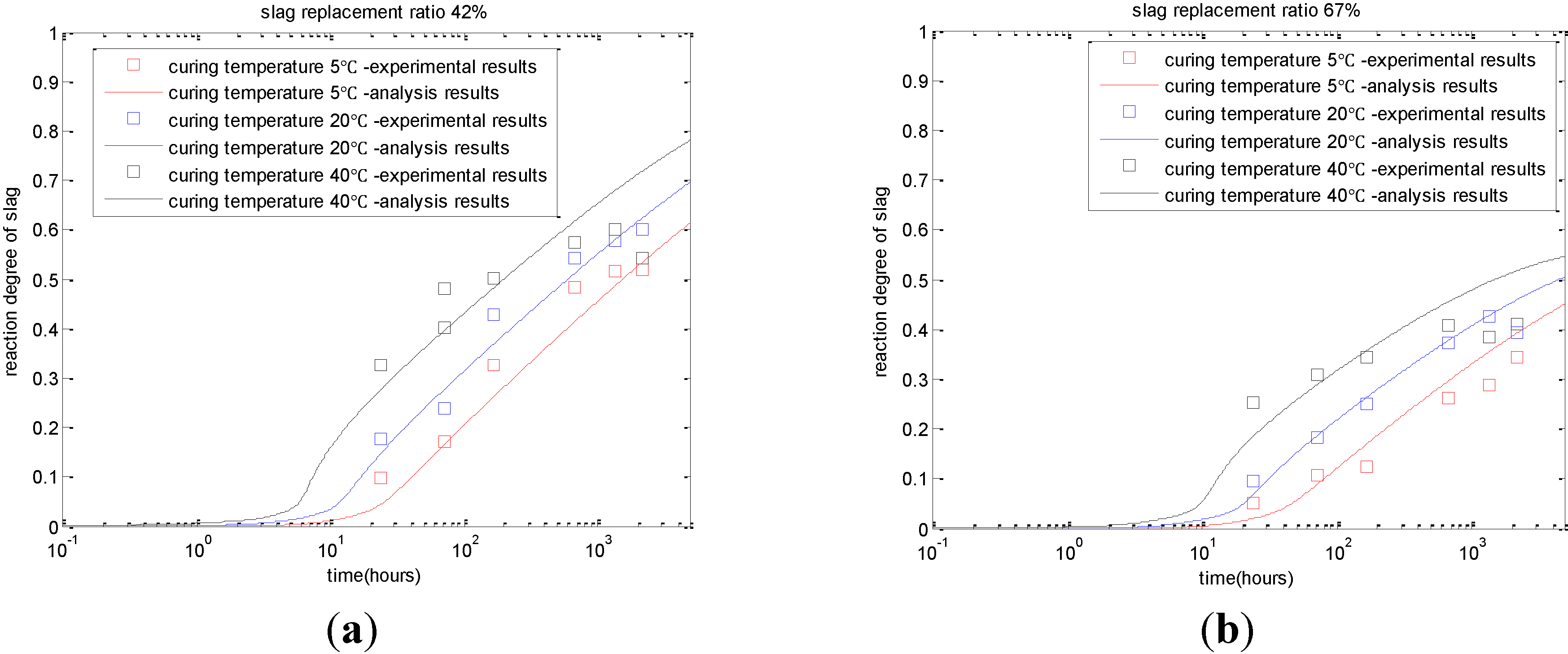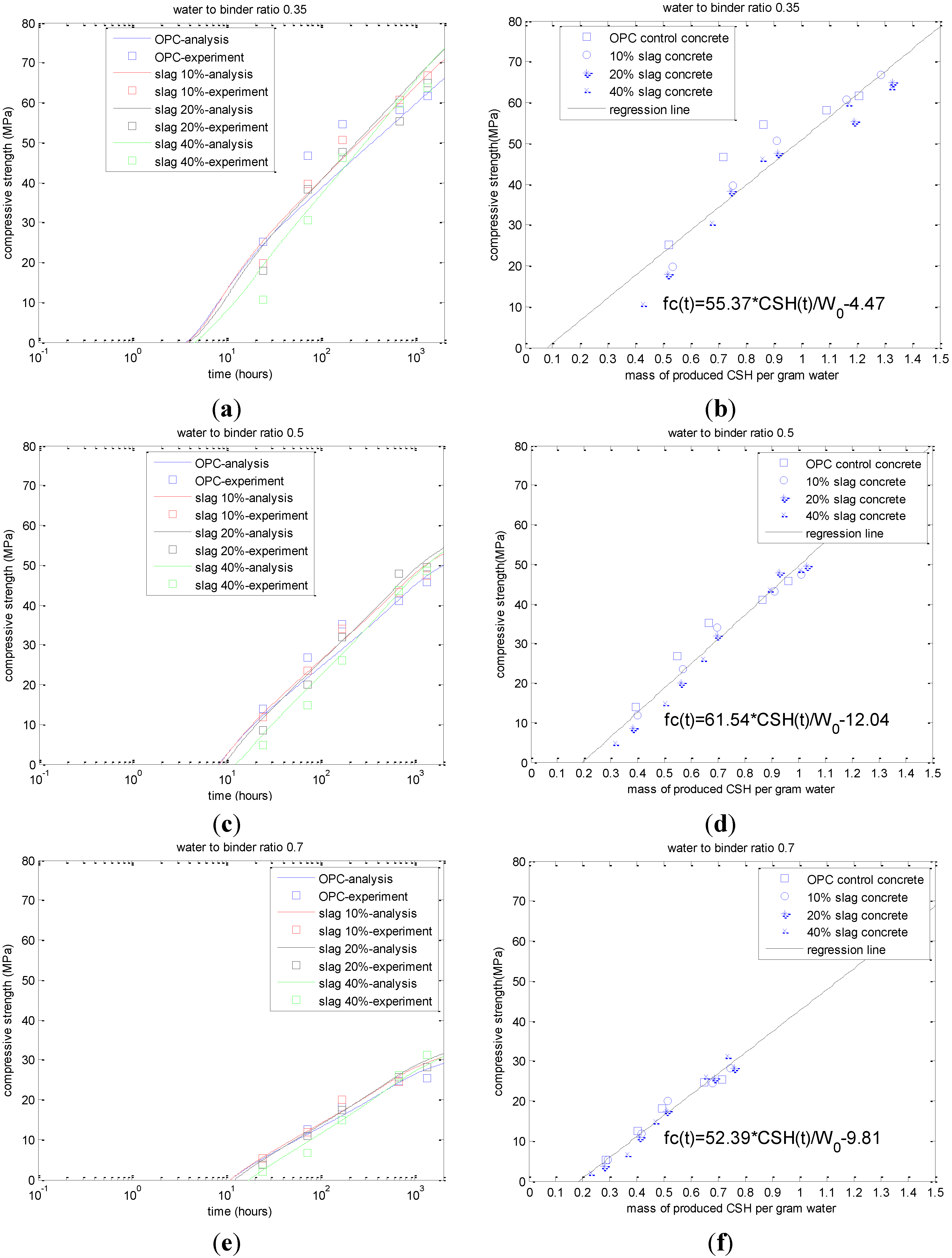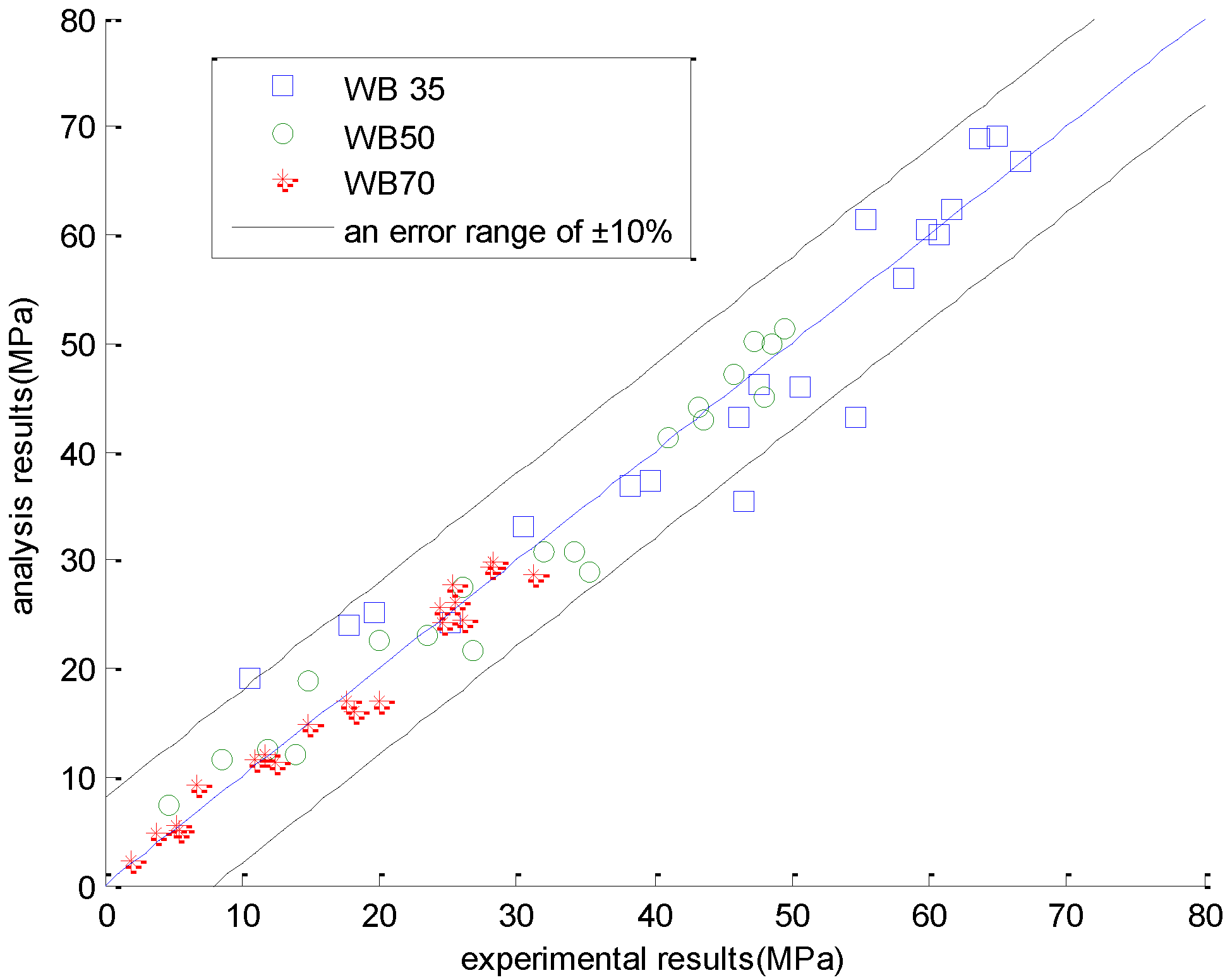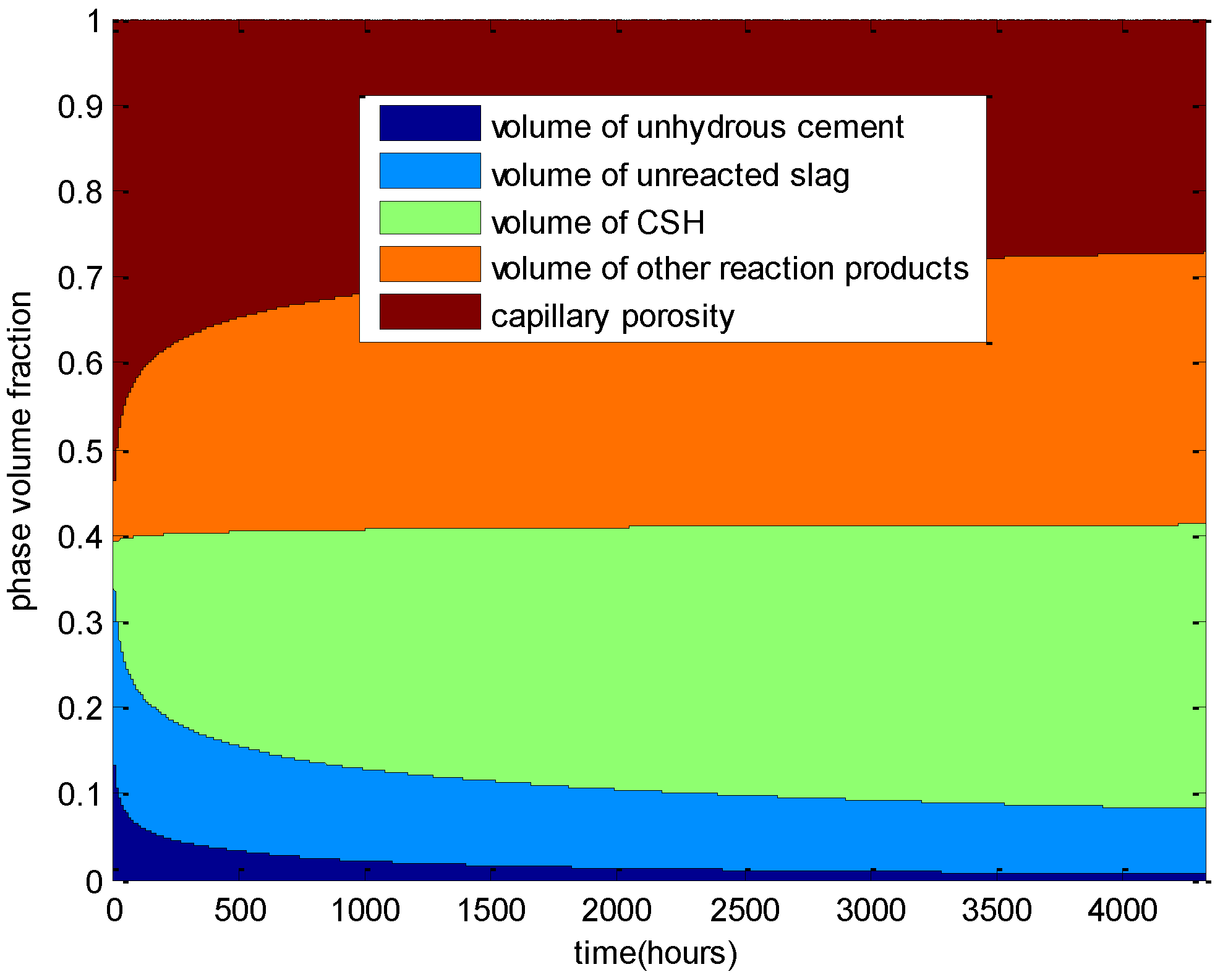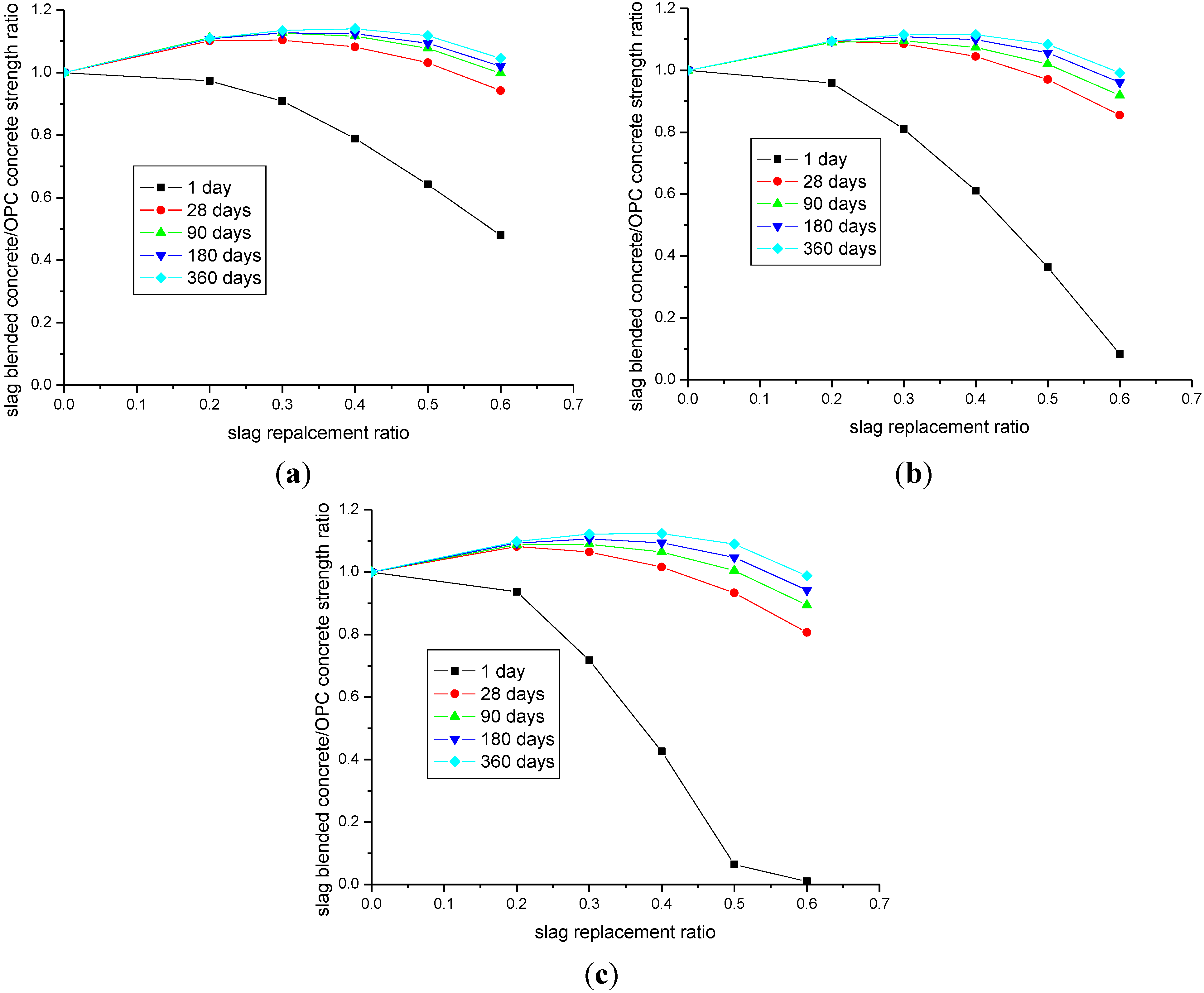1. Introduction
Slag is a by-product obtained during steel manufacturing and is commonly used in concrete because it improves durability and reduces porosity by improving the interface with the aggregate. Economic and ecologic benefits in the form of energy-savings and resource-conserving properties can also be achieved using slag-blended cement [
1,
2].
Compressive strength is the most important engineering property of concrete. To ensure progress in construction and safety in engineering practices, we aim to develop understanding on the strength development of concrete. Many experimental investigations have been conducted on the strength development of slag-blended concrete. The strength development of slag-blended concrete closely relates to the water-to-binder ratio, slag replacement ratio, and curing conditions. Beushausen
et al. [
3] found that, under moist curing conditions and when the slag replacement ratio is less than 50%, the 1-day early-age strength of concrete almost linearly decreases with the increase in the slag replacement ratio. At the ages of 28 and 56 days, due to the formation of calcium silicate hydrate (CSH) from the slag reaction, the compressive strength of slag-blended concrete can surpass that of control Portland cement concrete. Shariq
et al. [
4] found that, for concrete incorporating larger slag content (higher than 60% of the binder content), until the age of 180 days, the compressive strength of slag-blended concrete is still lower than that of Portland cement concrete. Oner and Akyuz [
5] systematically investigated the effect of slag inclusions on the compressive strength development of concrete. They found that at a late age of 365 days, compressive strength of concrete mixtures containing slag increases as the amount of slag increases. After an optimum point of slag, a further increase in slag no longer improves the compressive strength.
To theoretically deduce the optimum usage of slag, models for compressive strength development of slag-blended concrete are necessary. Compared with abundant experimental studies [
3,
4,
5], theoretical analysis of the compressive strength development of slag-blended concrete is limited. For comparing the relative performance of various supplementary cementing materials (SCMs: silica fume, fly ash, slag, natural pozzolans,
etc.) as regards Portland cement, Papadakis [
6,
7] proposed an efficiency factor of SCMs that can be considered as equivalent to Portland cement. However, it should be noted that Papadakis’ model [
6,
7] does not consider the effects of curing age and slag replacement ratios on the efficiency factor. Using a blended hydration model considering both cement hydration and slag reaction, De Schutter [
8,
9] evaluated the early-age strength development of hardening slag-blended concrete. For late-age concrete, due to the significantly decreasing heat evolution rate, it is difficult to use De Schutter’s model to evaluate the degree of hydration and strength development [
2]. In addition, when the slag replacement ratio and water-to-binder ratio change, the coefficients of De Schutter’s model will vary [
2]. Using an artificial neural network, Bilim [
10] evaluated the early-age strength and late-age strength of slag-blended concrete with different water-to-binder ratios and slag replacement ratios. However, we should note that artificial neural networks are a type of numerical regression method. Many parameters are necessary to build the input layer and hidden layers of artificial neural networks. The physical meaning of these parameters is not clear. Hence, it is difficult to adopt current models [
5,
6,
7,
8,
9,
10] to evaluate the strength development of slag-blended concrete with different mixing proportions. Moreover, current models [
5,
6,
7,
8,
9,
10] cannot be used to analyze the optimum usage of slag in concrete mixtures.
To overcome the weaknesses of the current research [
5,
6,
7,
8,
9,
10], this paper presents a numerical procedure to simulate the cement hydration, slag reaction, microstructure and strength development of hardening slag-blended concrete. The properties of concrete are determined considering contributions from cement hydration and slag reaction. Using parameter analysis of the compressive strength development of concrete with different slag inclusions, the optimum usage of slag in concrete mixtures is determined.
The innovations of this research are as follows. First, the proposed numerical procedure is valid for concrete with various mixing proportions, such as different water-to-binder ratios or different slag replacement ratios. The dependences of cement and slag reactivity on concrete mixing proportions and curing conditions are clarified; Second, the proposed numerical procedure is valid for both early-age concrete and late-age concrete. Evolutions of concrete properties are expressed as functions of reaction degrees of cement and slag; Third, the proposed numerical procedure evaluates the macro properties, such as the compressive strength of concrete, by using the microstructures of concrete such as the CSH content and phase volume fraction. The physical meanings of parameters in the proposed model are much clearer than those used in the artificial neural network model [
10].
3. Analysis of Optimum Usage of Slag for the Compressive Strength of Concrete
As reported by Papadakis [
6,
7], the compressive strength of concrete is mainly dependent on the amount of calcium silicate hydrate (CSH). For hardening slag-blended concrete, as shown in Equation (13), the amount of CSH relates to both the cement hydration and slag reaction. As proposed by Neville [
17], the relation between the compressive strength of concrete and CSH contents can be described by a linear equation as follows:
where
is the compressive strength of concrete, and
and
are coefficients related to compressive strength. As shown in this equation, for hardening concrete, the compressive strength development starts after a threshold degree of hydration. When the degree of hydration is less than this threshold degree of hydration, the compressive strength of concrete is zero. The concept of threshold degree of hydration is similar to that of the final setting time of concrete (final set means complete solidification and the beginning of hardening, and in concrete technology, hardening is the phenomenon of strength gain with time [
1]).
The experimental results of Cheng
et al. [
18] are used to verify the proposed model. In the study, three water/binder ratios (0.35, 0.50, and 0.70) and three substitution ratios of cement with slag (10%, 20%, and 40%) were selected for the preparation of concrete specimens. The cement used is ASTM type I cement, the fineness of the granulated blast furnace slag is 4000 cm
2/g, the maximum size of the coarse aggregate is 20 mm, and the fineness modulus of the fine aggregate is 2.96. The chemical compositions of cement and slag are shown in
Table 3 and
Table 4, respectively. The mixture proportions of concrete are shown in
Table 5. The size of the cylinder specimen for the compression test is 100 × 200 mm. The specimens were tested at five ages (1, 3, 7, 28, and 56 days) for the compressive strength measurement.
Using the blended cement hydration model, the amount of CSH can be calculated and is shown in
Figure 4. As shown in this figure, for early-age slag-blended concrete, the produced CSH contents are less than that of control concrete, while for late-age slag-blended concrete, the CSH contents can surpass that of the control Portland cement concrete. With the increase in the slag replacement ratio from 0.2 to 0.6, the age corresponding to the surpassing of CSH will be postponed. Alternately, based on the calculated CSH contents and measured compressive strength of concrete, the strength coefficients of Equation (14) can be calibrated. The values of
A1 for a water-to-binder ratio of 0.7, 0.5, and 0.35 are 52.39, 61.54, and 55.37, respectively. The values of
A2 for a water-to-binder ratio of 0.7, 0.5, and 0.35 are 9.81, 12.04, and 4.47, respectively.
Table 3.
Chemical composition of Portland cement [
18].
Table 3.
Chemical composition of Portland cement [18].
| Chemical Composition (mass %) | Blaine (cm2/g) |
|---|
| SiO2 | Al2O3 | Fe2O3 | CaO | MgO | SO3 | L.O.I |
|---|
| 20.6 | 4.0 | 6.1 | 62.8 | 2.6 | 3.1 | 0.8 | 3090 |
Table 4.
Chemical composition of slag [
18].
Table 4.
Chemical composition of slag [18].
| Chemical Composition (mass %) | Blaine (cm2/g) |
|---|
| SiO2 | Al2O3 | Fe2O3 | CaO | MgO | SO3 | Na2O | K2O | L.O.I |
|---|
| 34.4 | 9.0 | 2.58 | 44.8 | 4.43 | 2.26 | 0.62 | 0.5 | 1.32 | 4000 |
Table 5.
Mixing proportions of concrete containing slag [
18].
Table 5.
Mixing proportions of concrete containing slag [18].
| Water-to-Binder Ratio | Slag Replacement Ratio | Water (kg/m3) | Cement (kg/m3) | Slag (kg/m3) | Sand (kg/m3) | Aggregate (kg/m3) | Water Reducing Agent (Binder ×%) |
|---|
| WB35 | 0.35 | - | 202.8 | 591 | 0 | 570 | 973 | 4.1 |
| WB35-10 | 0.35 | 10% | 202.8 | 532 | 59 | 565 | 973 | 4.1 |
| WB35-20 | 0.35 | 20% | 202.8 | 473 | 118 | 560 | 973 | 4.1 |
| WB35-40 | 0.35 | 40% | 202.8 | 355 | 236 | 552 | 973 | 4.1 |
| WB50 | 0.5 | - | 206.5 | 414 | 0 | 718 | 973 | 0.4 |
| WB50-10 | 0.5 | 10% | 206.5 | 372 | 41 | 715 | 973 | 0.4 |
| WB50-20 | 0.5 | 20% | 206.5 | 331 | 83 | 712 | 973 | 0.4 |
| WB50-40 | 0.5 | 40% | 206.5 | 248 | 165 | 706 | 973 | 0.4 |
| WB70 | 0.7 | - | 206.9 | 296 | 0 | 815 | 973 | 0 |
| WB70-10 | 0.7 | 10% | 206.9 | 266 | 29 | 815 | 973 | 0 |
| WB70-20 | 0.7 | 20% | 206.9 | 237 | 59 | 812 | 973 | 0 |
| WB70-40 | 0.7 | 40% | 206.9 | 177 | 118 | 807 | 973 | 0 |
Figure 4.
Calculated calcium silicate hydrate (CSH) content. (a) water-to-binder ratio of 0.35; (b) water-to-binder ratio of 0.5; (c) water-to-binder ratio of 0.7.
Figure 4.
Calculated calcium silicate hydrate (CSH) content. (a) water-to-binder ratio of 0.35; (b) water-to-binder ratio of 0.5; (c) water-to-binder ratio of 0.7.
At the macroscopic level, concrete is a composite material consisting of discrete aggregates dispersed in a continuous cement paste matrix. The bonding region or interfacial transition zone (ITZ) in concrete between the matrix and aggregate is a critical component of mechanical performance [
19]. For ordinary strength concrete (water-to-binder ratio of 0.5) and low strength concrete (water-to-binder ratio of 0.7), the ITZ is the weak link of concrete, and the compressive strength of concrete is mainly dependent on the strength of the ITZ. When the water-to-cement ratio decreases from 0.7 (low strength concrete) to 0.5 (ordinary strength concrete), the distribution of reaction products in the ITZ becomes more homogeneous [
16], and the contribution of 1 gram of CSH to the compressive strength will increase. Hence, when the water-to-cement ratio decreases from 0.7 to 0.5, the strength coefficient
A1 increases from 52.39 to 61.54. Alternately, for high strength concrete (water-to-binder ratio of 0.35), the strength of concrete relates to three phases of concrete,
i.e., the ITZ phase, bulk paste matrix phase, and aggregate phase. Due to the contribution of the aggregate to the compressive strength, the ratio of the strength of the ITZ to the sum of the other two phases (bulk paste matrix paste plus aggregate phase) will decrease. Thus, when the water-to-cement ratio decreases from 0.5 to 0.3, the strength coefficient
A1 also decreases from 61.54 to 55.37.
Figure 5 shows the analysis results for the compressive strength development of slag-blended concrete. First, the proposed model can reflect the effect of the water-to-cement ratio on the compressive strength development of concrete. With the increase in the water-to-cement ratio, given a certain age, the produced CSH content for 1 gram of mixing water will decrease. Hence, the compressive strength will decrease correspondingly; Second, as shown in
Figure 5a,c,e, the proposed model can reproduce the strength crossover phenomenon between the control Portland cement concrete and the slag-blended concrete. Because the reactivity of slag is lower than that of Portland cement, the early-age strength of slag-blended concrete is lower than that of the control concrete. However, because the produced CSH content from 1 gram of reacted slag is higher than that from 1 gram of hydrated cement, at late age, for concrete containing 10%, 20%, and 40% slag, the compressive strength of slag-blended concrete can surpass that of the control concrete. In addition, with the increase in the slag replacement ratio, the reactivity of slag will decrease and the age corresponding to the crossover of the compressive strength will be postponed; Third, as shown in
Figure 5a,c,e, given certain water-to-binder ratios, with the increase in slag content, the
X-axis intercept of the strength development function increases correspondingly. This agrees with Brooks
et al.’s study [
20] on the setting time of slag-blended concrete. They reported that the inclusion of slag at replacement levels of 40% and greater resulted in significant retardation in setting times. As the replacement levels of slag were increased, there was greater retardation in setting times. On the other hand, as shown in
Figure 5b,d,f, with the increase in the water-to-binder ratio, the
X-axis intercept of the strength development function will increase. Neville [
18] also reported that the setting of concrete increases with an increase in the water-to-binder ratio.
Figure 5.
Analysis of the compressive strength development (experimental results are taken from reference [
18]). (
a) compressive strength
versus age: water-to-binder ratio of 0.35; (
b) compressive strength
versus CSH: water-to-binder ratio of 0.35; (
c) compressive strength
versus age: water-to-binder ratio of 0.5; (
d) compressive strength
versus CSH: water-to-binder ratio of 0.5; (
e) compressive strength
versus age: water-to-binder ratio of 0.7; (
f) compressive strength
versus CSH: water-to-binder ratio of 0.5.
Figure 5.
Analysis of the compressive strength development (experimental results are taken from reference [
18]). (
a) compressive strength
versus age: water-to-binder ratio of 0.35; (
b) compressive strength
versus CSH: water-to-binder ratio of 0.35; (
c) compressive strength
versus age: water-to-binder ratio of 0.5; (
d) compressive strength
versus CSH: water-to-binder ratio of 0.5; (
e) compressive strength
versus age: water-to-binder ratio of 0.7; (
f) compressive strength
versus CSH: water-to-binder ratio of 0.5.
Figure 6 presents a holistic comparison between the experimental results and the analysis results. As shown in this figure, the analysis results generally agree with the experimental results. For high strength concrete with a water-to-binder ratio of 0.35, due to the ignorance of the aggregate contribution to the compressive strength, the analysis results slightly deviate from the experimental results.
Figure 6.
Comparison between the analysis results and experimental results (experimental results are taken from reference [
18]).
Figure 6.
Comparison between the analysis results and experimental results (experimental results are taken from reference [
18]).
Figure 7 presents the evolution of the phase volume fractions of hardening cement-slag blends (water-to-binder ratio of 0.5 with 50% slag, curing temperature of 20 °C). As shown in this figure, with the progression of cement hydration and slag reaction, the volumes of un-reacted cement and slag decrease, the volumes of CSH and other reaction products increase, and due to the filling effects of the reaction products, the volume of the capillary pore decreases. At an early age, cement hydration and slag reaction proceed quickly, and at a late age, the reaction rates become slower. Because the reactivity of cement is much higher than that of slag, at the age of 180 days, the volume of anhydrous cement is much less than that of unreacted slag.
Figure 7.
Phase volume fraction evolutions of cement-slag paste: water-to-binder ratio of 0.5, slag replacement ratio of 0.5.
Figure 7.
Phase volume fraction evolutions of cement-slag paste: water-to-binder ratio of 0.5, slag replacement ratio of 0.5.
Figure 8 shows the parameter analysis of the effect of slag inclusion on the compressive strength development of concrete. The water-to-binder ratios shown in
Figure 8a–c are 0.35, 0.5, and 0.7, respectively. The vertical axis of these figures represents the ratio of the compressive strength between slag-blended concrete and the control Portland cement concrete. As shown in the figures, at the early age of 1 day, with the increase in the slag replacement ratio, the compressive strength of slag-blended concrete almost linearly decreases. As the curing age increases, obviously, the strength of slag-blended concrete with higher slag ratios increases faster, and at a late age, such as 360 days, the maximum value of the strength lies roughly at the slag replacement ratio of 40%. With regard to a slag replacement ratio higher than 40%, due to the lower reactivity of slag (shown in
Figure 1), the ultimate strength ratio is less. At the age of 360 days, because of losses in the capillary water, the decrease in available deposition spaces for hydration products, and a change in the hydration rate-determining process to a diffusion-controlled stage, the rate of the reaction becomes much slower, and the change in the compressive strength ratio between slag-blended concrete and OPC concrete is very marginal. Based on the evolution of the compressive strength ratio of concrete with different water-to-binder ratios and different slag inclusions, a slag replacement ratio of 40% can be regarded as the optimum slag content of concrete.
Figure 8.
Effects of slag inclusions on the compressive strength development of concrete. (a) water-to-binder ratio of 0.35; (b) water-to-binder ratio of 0.5; (c) water-to-binder ratio of 0.7.
Figure 8.
Effects of slag inclusions on the compressive strength development of concrete. (a) water-to-binder ratio of 0.35; (b) water-to-binder ratio of 0.5; (c) water-to-binder ratio of 0.7.
A summary regarding the determination of optimum slag content is as follows: First, using experimental results on the reaction degree of slag, the reaction coefficients of the slag reaction model are calibrated; Second, using experimental results on the compressive strength, the strength development coefficients of slag-blended concrete are calibrated; Third, parameter analysis of the compressive strength development of Portland cement concrete and slag-blended concrete is performed. By comparing the strength development of slag-blended concrete with that of Portland cement concrete, the optimum slag content can be analyzed.
4. Conclusions
This paper has proposed a numerical procedure to analyze the optimum usage of slag for the compressive strength of concrete. The conclusions are summarized as follows.
First, we proposed a blended hydration model that simulates cement hydration, slag reaction, interactions between cement hydration and slag reaction, and phase volume fraction evolution of cement–slag blends. The amount of calcium silicate hydrate (CSH), which is closely related to the compressive strength of concrete, is calculated considering the contributions from both cement hydration and slag reaction.
Second, by using a linear equation for the compressive strength and CSH content, the development of the strength of slag-blended concrete is evaluated. Given a certain age, with an increase in the water-to-binder ratio, the compressive strength of concrete will decrease. The proposed model can reproduce the strength crossover phenomenon between the control Portland cement concrete and slag-blended concrete. The early-age strength of slag-blended concrete is lower than that of the control concrete. However, at a late age, for concrete containing 10%, 20%, and 40% slag, the compressive strength of slag-blended concrete can surpass that of the control concrete. With an increase in the slag content and the water-to-binder ratio, the starting age of the compressive strength development will be retarded.
Third, based on parameter analysis, the ratio of the compressive strength between slag-blended concrete and Portland cement concrete is calculated. For concrete with different water-to-binder ratios, at the late age of 360 days, the optimum slag content is approximately 40% of the total binder content. Before this optimum point, the compressive strength of concrete mixtures containing slag increases as the amount of slag increases. After an optimum point, any further increase in slag inclusion does not improve the compressive strength.
